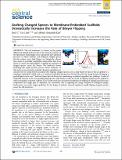Grafting Charged Species to Membrane-Embedded Scaffolds Dramatically Increases the Rate of Bilayer Flipping
Author(s)
Van Lehn, Reid C.; Alexander-Katz, Alfredo
DownloadGrafting charged species.pdf (4.972Mb)
PUBLISHER_POLICY
Publisher Policy
Article is made available in accordance with the publisher's policy and may be subject to US copyright law. Please refer to the publisher's site for terms of use.
Terms of use
Metadata
Show full item recordAbstract
The cell membrane is a barrier to the passive diffusion of charged molecules due to the chemical properties of the lipid bilayer. Surprisingly, recent experiments have identified processes in which synthetic and biological charged species directly transfer across lipid bilayers on biologically relevant time scales. In particular, amphiphilic nanoparticles have been shown to insert into lipid bilayers, requiring the transport of charged species across the bilayer. The molecular factors facilitating this rapid insertion process remain unknown. In this work, we use atomistic molecular dynamics simulations to calculate the free energy barrier associated with "flipping" charged species across a lipid bilayer for species that are grafted to a membrane-embedded scaffold, such as a membrane-embedded nanoparticle. We find that the free energy barrier for flipping a grafted ligand can be over 7 kcal/mol lower than the barrier for translocating an isolated, equivalent ion, yielding a 5 order of magnitude decrease in the corresponding flipping time scale. Similar results are found for flipping charged species grafted to either nanoparticle or protein scaffolds. These results reveal new mechanistic insight into the flipping of charged macromolecular components that might play an important, yet overlooked, role in signaling and charge transport in biological settings. Furthermore, our results suggest guidelines for the design of synthetic materials capable of rapidly flipping charged moieties across the cell membrane.
Date issued
2017-02Department
Massachusetts Institute of Technology. Department of Materials Science and EngineeringJournal
ACS Central Science
Publisher
American Chemical Society (ACS)
Citation
Van Lehn, Reid C., and Alexander-Katz, Alfredo. “Grafting Charged Species to Membrane-Embedded Scaffolds Dramatically Increases the Rate of Bilayer Flipping.” ACS Central Science 3, 3 (March 2017): 186–195 © 2017 American Chemical Society
Version: Final published version
ISSN
2374-7943
2374-7951